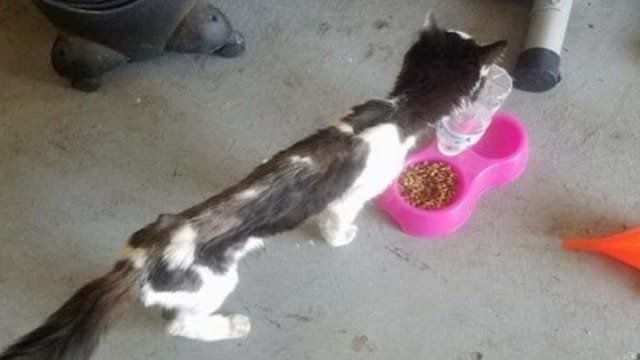In this April 29, 2016, image made from video provided by Cat TV host Koo Eun-je, stray cats approach foods prepared by South Korean Koo Eun-je, the 35-year-old host of the online Cat TV, at “a restaurant for cats” in JeollaNamdo, South Korea.
(Photo: AP)
JANGSEONG, SOUTH KOREA - This story is about as heart-warming as it gets, folks!
The stars of the latest online trend in South Korea just so happen to stay out of sight most of the day. Viewers don’t seem to mind waiting for hours while absolutely nothing happens. When the stray cats finally come to eat the food that is left out for them, people watching online sit hypnotized by their feline charms.
The livestreamed “Cats Meok Bang” show is a new twist on an online trend of young South Korean men and women tucking into feasts in real time, while viewers send messages and sometimes virtual cash. In a country where young adults increasingly live and dine by themselves, the shows have become so popular, some hosts have made small or big fortunes from the virtual cash sent from viewers to help support the cats.
While the stars of those programs seek a rapport with their fans, cat TV has recently gained viewers despite its uneventfulness. Some avid fans say they have simply quit watching soap operas, reading online news or playing mobile phone game to watch. One says instead of smoking every time he gets stressed at work, watching the cats helps to restore his peace of mind. While cats have generally fascinated the Internet, a show devoted to watching them eat is quite unusual. However, it has helped change negative images of stray cats in South Korea, which has traditionally seen them as thieves.
“Cats Meok Bang,” a mash-up of the Korean words for broadcasting and eating, all began by accident. While visiting his mother-in-law in a mountainous village in southwestern Korea, Koo Eun-je saw a cat outside and he wondered how it survived and put out leftover fish for it. The next day, the cat was back and so Koo decided to keep feeding him, and the others who followed. Finally, he went on to set up a surveillance camera and livestreamed the scene online.
“We started the channel simply for me and my wife to watch, but other viewers also started watching it,” the 35-year-old who previously worked as a web designer stated in an interview near the lake where he goes bass fishing for the cats. “We guessed that there would be one or two cats, but now it turns out that 17 cats are coming to eat food.”
Four months later, 110,000 South Koreans watched the show on a monthly average and more than 10,000 of them have even gone so far as to bookmark the show. Some viewers sent him virtual cash items, which have helped cover his living expenses and cat food. Others send food and donations to Koo. As his cat TV got popular, at least one othercopycat show emerged.
Koo has turned the area outside the family home into what he refers to as “a restaurant for cats.” Its decorations change regularly. A chalkboard even features the day’s menu, and about a dozen cats’ nicknames are written on a little piece of paper. A fish bowl and trays of food sits on a pink blanked which covers the ground. Everything is at a standstill except a pinwheel which spins in the background and small toys, a rubber duck and sometimes hula dancers, in the foreground. Serene music also plays from a speaker. Larger toys like a Hello Kitty doll are placed in the background, and beyond them are rice and pepper farms and a patch of sky.
Sometimes birds happen to fly by. Other times, Koo’s mother-in-law can be seen sweeping outside the house. Once or twice a day, Koo appears onscreen, re-stocking the food dishes.
When a cat finally enters the scene, viewers can share their excitement, exchange live chats, and even call out the cat’s name and tell them to eat well.
“They are like unexpected joy suddenly visiting you,” stated Park Tae-kyung, a 33-year-old computer graphic designer in Seoul. For the past two months or so, Park said she played the cat TV all day at work on a computer screen and watched the show before going to bed. When she spotted a cat at work, all of her colleagues rushed to the screen to stare at it.
During the slow hours after patients leave his office, Yoo Young Hoon, a 49-year-old physician who works in Seoul, said he always plays the cat TV on the screen next to the medical chart. The show has even replaced his time on Facebook and his day is full of newfound cat-related activities although he still does not plan to adopt one.
“I was never fond of cats before,” he stated. “Now when I take a walk after lunch, I go to places where I might run into street cats.”
The only game he plays now, he said, is Neko Atsume, the popular mobile game where users collect and feed cats.
Unlike dogs that are considered loyal to their owners, cats do not have a very positive image in South Korea. Stray cats are called “thief cats” because they are believed to survive only by stealing food from humans. They are unwelcomed creatures who go through rubbish.
Furthermore, many of South Korea’s older generations still view cats as a wicked, untrustworthy animal.
But viewers of the cat TV said they began paying attention to those animals roaming around the street with a greater affection.
“I always walked looking straight ahead. But now once in a while I look down, like beneath a car, to see what kind of cats live near my house,” Park stated. “When looked closely, those street cats were full of charms.”
Fortunately, the reactions from Koo’s mostly elderly neighbors were quite heart-warming.
“They were surprised how devotedly the meals were prepared,” Koo, the host of the cat TV, stated. “I wish the show would be remembered as a channel that people can blankly stare the cats eating and rid their stress and worries from life.”




